ProMat Show Recap 2025
- zachk
- Apr 3
- 3 min read

The manufacturing and supply chain community came together for a record-setting ProMat exhibition, according to show producer MHI. With an overall registration count of 52,223 and 1,160 exhibitors, ProMat included 659,000 net square feet of exhibit solutions and 215 educational sessions across three show halls at Chicago’s McCormick Place. This was the largest ProMat to date for MHI, with 3% more registered attendees than the last ProMat. Attendees came from the United States and 143 countries across the globe.

ProMat 2025 showcased several key technological innovations and trends for supply chain and manufacturing professionals, as highlighted in the sources.
One significant trend was the focus on labor reduction through automation. Exhibitors presented various technologies aimed at minimizing training needs, simplifying work processes, and automating functions to address the challenges of finding enough personnel.
Another prominent trend was verticality, with many new facilities designed with higher roofs to maximize vertical storage and minimize real estate costs. This indicates a focus on space optimization in warehousing.
The exhibition also highlighted the emergence and impact of OEM-backed startups, where major companies are creating incubators or venture capital arms to foster new ideas and product innovations. This suggests a dynamic landscape of innovation driven by established industry players.
In terms of specific technologies, autonomous mobile robots (AMRs) and automated guided vehicles (AGVs) were prominent. CaPow introduced the Genesis Antenna XL, a long-range modular floor antenna for in-motion power for robotic fleets, aiming to eliminate downtime and improve safety by moving away from traditional contact-based charging with large lithium-ion batteries. This technology provides continuous power and supports 100% uptime for AGVs and AMRs.
Autonomous forklifts were also a key area, with MyBull demonstrating its unmanned forklifts designed for round-the-clock operation, cargo transfer, shelf access, trailer docking, and pallet stacking. These forklifts boast high repeat accuracy and customizable attachments for various warehouse and logistics environments. Hyster also announced an expanded lineup of high-capacity electric forklifts with integrated lithium-ion batteries, offering a zero-emission alternative with customizable battery sizes for demanding environments.
Innovations in conveyance were also present. ProVeyance Group launched the Ashland ProFlex Power conveyor designed to cut energy use and last up to five times longer than competing designs due to its robust construction and contoured drive belt. The conveyor also features easy belt replacement, reducing maintenance time. Gorbel expanded its Portable Ergonomic Conveyor offerings with the Destuff-it 2.0, featuring new configurations to optimize operator positioning and reduce the risk of injury during loading and unloading.
Mobile robotics for heavy loads and tight spaces was another area of innovation, exemplified by KUKA's KMP 3000P omnimove robot capable of moving up to 3 tons. This robot uses induction charging and integrated 3D cameras and laser scanners for navigation and demonstrated material supply to a robot arm.
Data acquisition and processing capabilities were showcased by MyBull, with its handheld and backpack Panoramic Mobile Mapping and Acquisition Equipment. These devices can capture 8K 360° panoramic images and 3D point clouds in challenging environments and are compatible with drones and robots for various applications like indoor navigation and mapping. MyBull also highlighted its Positioning and Navigation System (PNS) for precise localization of autonomous vehicles in complex industrial settings.
Safety systems also saw innovation with A-SAFE's launch of A-GUARD, a machine-guarding system that uses wireless technology and clear polymer panels to provide 100% interior visibility while ensuring comprehensive protection. The system is adaptable, allows for real-time monitoring of panel removal and impacts, and helps optimize maintenance schedules.
The integration of artificial intelligence was noted as a trend, with AI-driven picking systems capable of automatically re-sorting misplaced goods being mentioned as a "cool technology" at the show. InOrbit's RobOps Copilot, which applies LLMs to mobile robot fleet optimization, further exemplifies this trend.
Finally, the trend of "cool technology" encompassed various nifty ideas on display, including robots that charge themselves while moving, AI-driven picking systems, and drones for inspection. MyBull also demonstrated synchronized operations of its autonomous tow tractors and forklifts, showcasing real-world scenarios of unmanned cargo handling.
In summary, ProMat 2025 emphasized automation for labor reduction, vertical storage solutions, innovation through OEM-backed startups, advancements in mobile robotics (AMRs, AGVs, autonomous forklifts) with features like in-motion charging and heavy payload capabilities, improvements in conveyance systems for efficiency and ergonomics, enhanced data acquisition and processing, and innovative safety measures, all increasingly leveraging artificial intelligence.
.png)
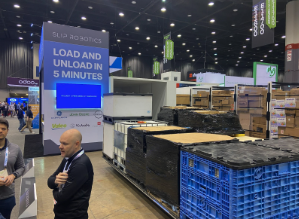

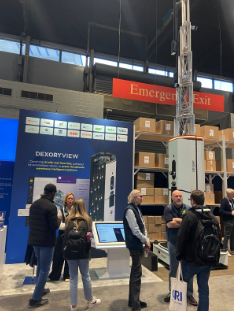
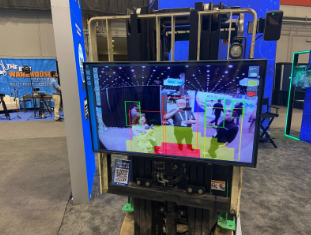
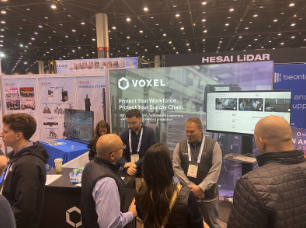
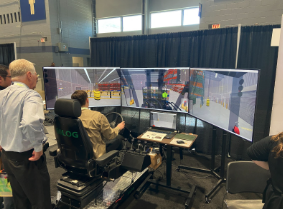





Comments